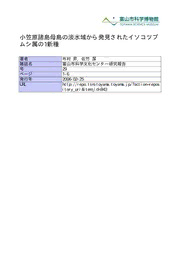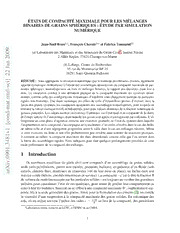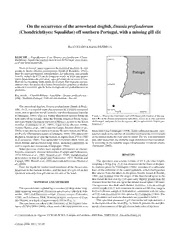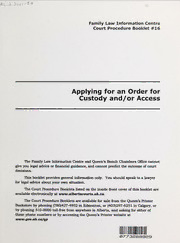
Applying for an order for custody and/or access PDF
Preview Applying for an order for custody and/or access
Au.a.aooi-S'^ Family Law Information Centre Court Procedure Booklet #16 Applying for an Order for Custody and/or Access The Family Law Information Centre and Queen’s Bench Chambers Office cannot give you legal advice or financial guidance, and cannot predict the outcome of court decisions. This booklet provides general information only. You should speak to a l awyer for legal advice about your own situation. The Court Procedure Booklets listed on the inside front cover of this booklet are available electronically at www.atbertaconrtScdb.ccL The Court Procedure Booklets are available for sale from the Queen’s Printer Bookstore by phoning (780)427-4952 in Edmonton, or (403)297-6251 in Calgary, or by phoning 310-0000 toll-free from anywhere in Alberta, and asking for either of these phone numbers or by accessing the Queen’s Printer website at www.gov. ab. ca/qp 077 3E889E9 Family Law Information Centres The Family Law Information Centres can provide information about: ■ the Federal Child Support Guidelines, ■ how to calculate child support, ■ how to apply for or change a C hild Support Order, ■ how to oppose an application that involves child support, and ■ the procedures that must be followed in other family law matters, such as spousal support and child custody. The Family Law Information Centres can be found at the following locations: Family Law Information Centre, Edmonton Family Law Information Centre, Calgary Law Courts Building Court House Annex 1A Sir Winston Churchill Square 603 - 6 th Avenue SW Edmonton, Alberta, T5J 0R2 Calgary, Alberta, T2P 0T3 Tel: 780-415-0404 Tel: 403-297-6600 Fax: 780-415-0403 Fax: 403-297-6605 Family Law Information Centre Court Procedure Booklets Applications Dealing With Child Support Or Arrears If y our application deals with child support or arrears, you should read the booklet “Information for Unrepresented Parties about Child Support Matters" before reading the appropriate procedure booklets below. Child Support — when both parties live in Alberta Obtaining Income Information from the Other Party for Child Support Applications Applying for an Order for Child Support Changing an Existing Order for Child Support Decreasing Child Support, Reducing or Cancelling Arrears, and Stay of Enforcement Reducing or Cancelling Arrears and Stay of Enforcement (where there is no change to ongoing support) Applying for an Order for Child Support Under the Parentage and Maintenance Act Applying for a C onsent Order that Includes Child Support Opposing an Application that Involves Child Support Child Support — when the respondent lives outside Alberta Provisional Application to Change an Order for Child Support - D ivorce Act Spousal Support Applying for an Order for Spousal Support Changing an Existing Order for Spousal Support Custody and Access Applying for an Order for Custody and/or Access Changing an Existing Order for Custody and/or Access Combination Applications Applying for an Order for Child Support and Custody and/or Access Changing an Existing Order for Child Support and Custody and/or Access Applying for an Order for Child Support and Spousal Support Changing an Existing Order for Child Support and Spousal Support Applying for an Order for Child Support, Spousal Support and Custody and/or Access Changing an Existing Order for Child Support, Spousal Support and Custody and/or Access Restraining or Protection Orders Applying for a R estraining Order Without Notice Applying for a P rotection Order on Notice Review of an Emergency Protection Order General Opposing an Application that Does Not Involve Child Support Applying for a C onsent Order that Does Not Include Child Support Transferring Your Court File General Family Law Application Family Law Information Centre Court Procedure Booklet #16 Applying for an Order for Custody and/or Access Digitized by the Internet Archive in 2016 https://archive.org/details/applyingfororder00fami_0 Contents About This Booklet 1 Before You Begin 2 Step 1: Prepare a N otice of Motion 3 Step 2: Prepare an Affidavit 3 Step 3: File the Affidavit and Notice of Motion and Choose a C ourt Date 5 Step 4: Serve the Application 6 Step 5: Prepare and File an Affidavit of Service 7 Step 6: Going to Court 8 Step 7: Prepare the Court Order 11 Step 8: Serve the Filed Order . 12 Step 9: Prepare and File an Affidavit of Service 12 Appendix 1: Explanation of Legal Terms .13 Appendix 2: Sample Court Forms 19 About this This booklet outlines what you must do when applying for Booklet a C ustody and/or Access Order. An application for custody and/or access must be made in the province where the children live. If the children do not live in Alberta do not use this booklet. You will need to speak to a lawyer. If y ou are applying to change an existing Custody and/or Access Order, instead refer to the Court Procedure Booklet, Changing an Existing Order for Custody and/ or Access. If the parents agree on custody and access, do not use this booklet. Rather, you can apply for a C onsent Order. It must be signed by a j udge, filed with the court, and it must follow court procedures. For more information, see Court Procedure Booklet, Applying for a C onsent Order that Does Not Include Child Support. If the parents do not agree on custody and access, then an application must be made to the court. You will need to follow each of the steps outlined in this booklet. The judge will determine the appropriate terms of the Order. The process outlined in this booklet is a v ery formal one that is designed to ensure fairness. It is important that you follow each step carefully and thoroughly. The legal terms that you will need to know are explained in Appendix 1. You should speak to a l awyer to determine if y ou have sufficient reasons to make the application, what evidence should be presented to the court, and possible outcomes for your application. If y ou decide to go ahead without a l awyer, you may need to consult other sources of information as you prepare your application. You can find the following documents at your local court house libraiy, other libraries or at the listed websites: ■ Alberta Rules of Court - w ww.gov.ab.ca/qp/rules.html ■ Family Law Practice Notes (attached to the Alberta Rules of Court) - www.albertacourts.ab.ca/webpage / q b/ qb_family_law_ practice_notes.htm 1 ■ Divorce Act - founder.libraiy.ualberta.ca/ftp/ en/laws /title / d /index, html ■ Domestic Relations Act - www.gov.ab.ca/qp/acts.html Before You There must be an Alberta Court Action started Begin Before you can make an application, there must be an existing Alberta court action between you and the other party. If y ou do not have an existing Alberta court action, you will need to speak to a l awyer. If y ou have a copy of the document that started the court action, such as a S tatement of Claim, you will find the court action number written on the backer. If y ou do not have any of your court documents, you can find out the court action number from the Clerk’s Office in the court house where the action was filed. There will be a f ee for this service. Your application must be made, and all documents filed, in the judicial district where your initial action (for example, divorce) was filed. A l ist of all Chambers or Clerk’s Offices located across the province (the judicial districts) is on the inside back cover of this booklet. If y ou want to transfer your court file to another judicial district, see the Court Procedure Booklet, Transferring Your Court File. Parenting After Separation Seminar If y ou haven’t already, you may have to attend the Parenting After Separation Seminar before you make your application. For more information about this, see the Notice Of Mandatory Seminar sheet, which is available from the Family Law Information Centre (please see the inside front cover of this booklet for locations) or Chambers Office (Clerk’s Office). 2 Step 1: You must complete a N otice of Motion Family Law Prepare a Application. It tells the court and respondent the date, time, Notice of and place of the upcoming application. The Notice of Motion Motion also includes everything that the applicant will be requesting from the court. A s ample of this form begins on page 21. When completing this form, you must: ■ mark the box before each item that you are requesting from the court and fill in any blanks for those items, ■ give a b rief statement of your reasons for making this application, and ■ sign your name at the bottom of the form. Right before your signature you are also asked to fill in the date that you swore your Affidavit in support. You will prepare this Affidavit in Step 2. Step 2: Affidavit evidence is the only type of evidence that a Prepare an chambers judge will accept. It is important to include Affidavit everything you need to prove your case and everything you want the judge to know. The only facts that you can discuss in court are those that are included in your or the other party's Affidavit on the court file. The facts that you include in your Affidavit must be complete, accurate and relevant to the application before the court. There are serious consequences if y ou do not tell the truth. Remember that the other party or their lawyer can cross-examine or ask you questions on anything you include. 2-1 Prepare an Affidavit You may use the sample Affidavit that begins on page 29. The facts in the Affidavit should be listed in separate numbered paragraphs. Each paragraph must be numbered consecutively (1,2,3...). Complete as much of the sample Affidavit as applies to your case. Then cross out any paragraphs that do not apply to your situation. See the instructions on page 20 on how to delete information from a court document. 3 Next, add any other facts you feel are necessaiy to support your application. You may need to print or type other clauses in order to present all of the facts in your own case. Remember that the Affidavit will be read by the judge. Make sure that it is readable and understandable. If y our Affidavit is messy or confusing, you will need to re-type the sample Affidavit. Identify each document that you refer to in the Affidavit as an “Exhibit” and letter each one consecutively (Exhibit “A,” Exhibit “B,” and so on). For example your Affidavit may discuss “a copy of a l etter from ABC school dated January 1, 2000, which is attached and marked as Exhibit A.” Then attach one copy of each exhibit, in alphabetical order, to the Affidavit, immediately after the signature page and immediately before the last page (called the backer). Label each exhibit clearly as Exhibit “A,” Exhibit “B,” and so on. 2-2 Swear or affirm to the truth of your Affidavit before a commissioner for oaths You must swear or affirm before a commissioner for oaths that the contents of your Affidavit are true. You may be asked to show personal identification. A C hambers Clerk may act as a commissioner for oaths. The commissioner for oaths will check to make sure that each exhibit mentioned in the Affidavit is attached to the Affidavit. Each exhibit will have to be stamped with an exhibit stamp. The commissioner for oaths has the stamp. The stamp must be filled in for each exhibit. It is the commissioner for oaths who must sign each completed stamp.
The list of books you might like

The 5 Second Rule: Transform your Life, Work, and Confidence with Everyday Courage

Rich Dad Poor Dad

$100m Offers

Atomic Habits James Clear

Illinois PTAC ... annual report

Bycatch, utilization, and discards in the commercial groundfish

The Retirement Years
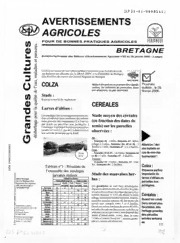
Avertissements Agricoles - Grandes cultures - Bretagne - 2006 - 2

Ungleichheit Warum wir nicht alle gleich viel haben müssen
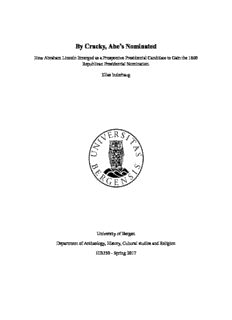
By Cracky, Abe's Nominated

Bon Dia Aruba (21 Januari 2006)

Journal of Vascular Surgery 1993: Vol 17 Index

AMO Overview

Vascular Flora of Isla del Coco, Costa Rica

C-uppsats_30 maj

Calixarene Complexes with Transition Metal, Lanthanide and Actinide Ions

Amazon Cognito - 개발자 안내서
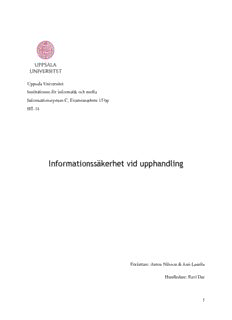
C uppsats Joni & Anton rev.2 .docx
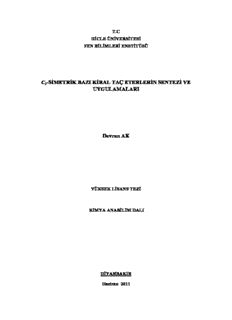
C2-SİMETRİK BAZI KİRAL TAÇ ETERLERİN SENTEZİ VE UYGULAMALARI Devran AK
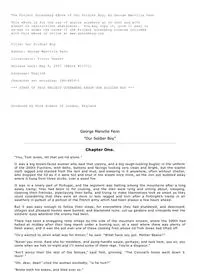
Our Soldier Boy by George Manville Fenn

